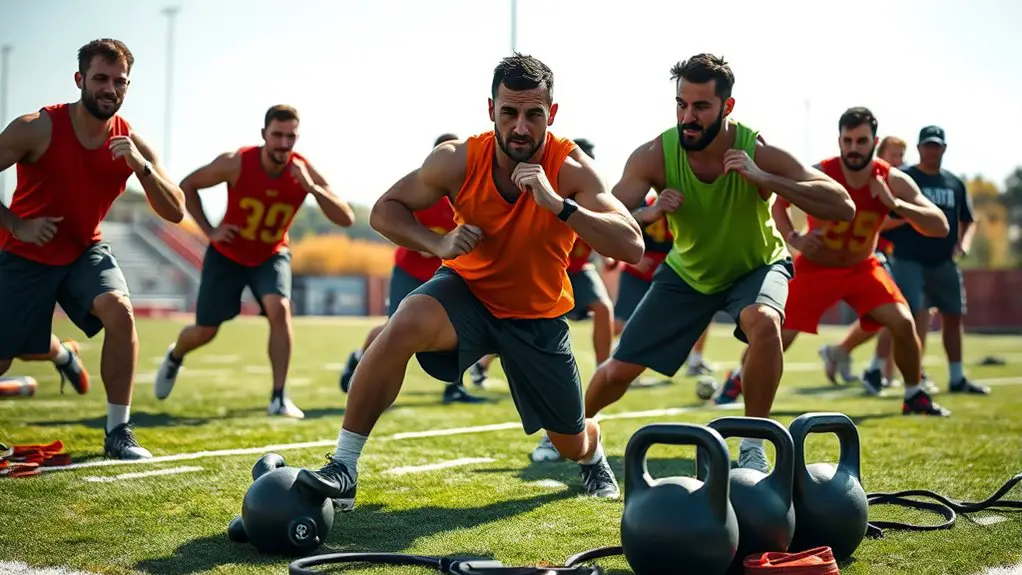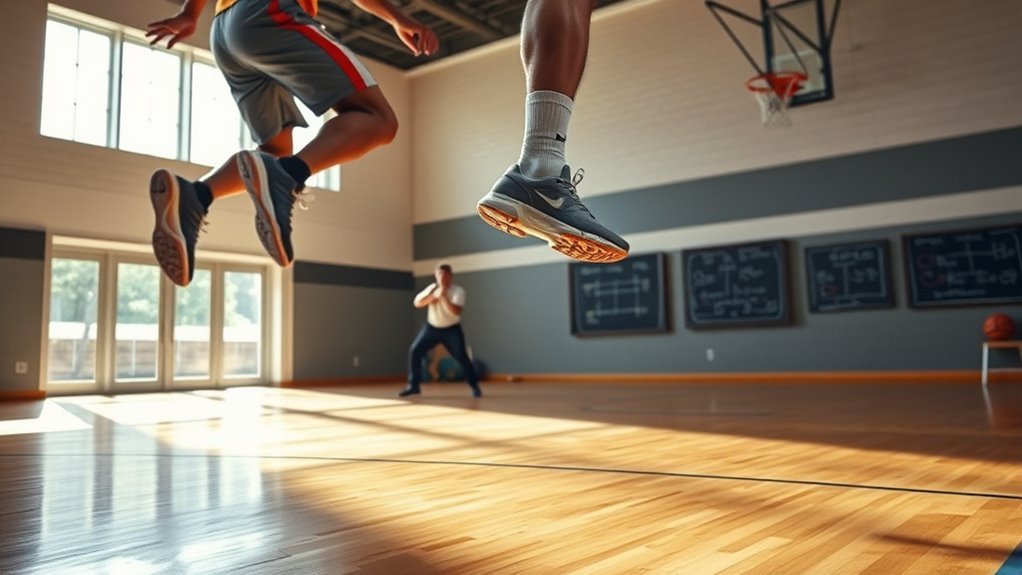Hip mobility plays an essential role in executing better forehand shots in tennis. When you have flexible hips, you can rotate your body efficiently and transfer energy effectively during your swing. This movement generates more power and speed, enhancing your overall shot dynamics. If you're experiencing limitations, it may affect your performance. By focusing on exercises to improve your hip mobility, you can boost your game. Keep going and discover more ways to enhance your shots and overall performance.
Understanding Hip Mobility and Its Importance in Tennis
When you step onto the tennis court, understanding hip mobility is vital for enhancing your performance. Hip flexibility plays an important role in executing powerful shots and maintaining fluid movement. You want to feel free and unrestricted, and that starts with your hips. Dynamic stretching is an effective way to increase hip mobility, preparing your body for the demands of the game. Incorporating exercises like leg swings and hip circles into your warm-up routine can make a significant difference.
The Anatomy of a Forehand Shot
When you prepare for a forehand shot, understanding the key muscle groups involved is essential. Your hips, shoulders, and core all play significant roles in generating power and control. Let's break down the joint mechanics to see how they contribute to an effective stroke.
Key Muscle Groups
A powerful forehand shot relies heavily on several key muscle groups working in harmony. Your hip flexors play an essential role, allowing for quick, explosive movements as you prepare to strike the ball. When you engage those hip flexors, you create a foundation for dynamic motion. But it doesn't stop there; glute activation is equally important. Strong glutes help stabilize your hips and provide the necessary power during your swing. By focusing on these muscle groups, you're not just enhancing your shot but also freeing up your movement on the court. Embrace this synergy, and you'll find your forehand improving greatly, giving you the freedom to express your game with confidence and force.
Joint Mechanics Explained
Understanding the joint mechanics involved in a forehand shot is essential for maximizing your performance on the court. Your body's joints must work in harmony to create effective movement patterns. The hips, shoulders, and wrists play vital roles, providing both joint stability and mobility. When you initiate the shot, your hips rotate, transferring energy through your core and into your shoulders. This coordinated movement creates a powerful whip-like effect, enhancing your shot's speed and accuracy. If your joints lack stability, however, you'll struggle to maintain control, leading to inconsistent shots. Focus on developing your hip mobility and strengthening your core to optimize your joint mechanics, allowing for smoother and more effective forehand shots. Embrace the freedom that comes with mastering these movements!
How Hip Movement Enhances Power in Your Forehand
While many players focus on their arm and racket techniques, the true power of your forehand often comes from hip movement. When you engage in proper hip rotation, you're tapping into a source of strength that can elevate your game. As you pivot your hips, you create a powerful kinetic chain that travels through your body, transferring energy right into your shot. This isn't just about swinging harder; it's about generating power with precision.
Imagine your hips acting like a coiled spring. As you rotate them, they release energy, providing that extra oomph to your forehand. You'll find that with the right hip movement, your shots not only feel stronger, but they'll also flow more naturally. Embracing this freedom of movement allows you to connect with the ball in a way that maximizes your potential, making every strike more effective and explosive. Additionally, incorporating functional mobility and flexibility drills can further enhance your hip movement, ensuring a more dynamic and powerful forehand.
The Connection Between Hip Rotation and Racket Speed
As you harness the power of hip rotation, you'll notice a direct impact on your racket speed. When you engage your hips, you're not just moving; you're releasing potential. As your hips rotate, they generate momentum that transfers seamlessly through your core and into your racket. This connection creates a fluid motion, allowing your racket to slice through the air with greater velocity.
Think about it: when you initiate your swing with your hips, you're setting the stage for explosive energy. A well-timed hip rotation can enhance your racket speed, making your forehand shots sharper and more dynamic. You'll feel the freedom in your movement, as if the court is yours to command. Mastering this relationship between hip rotation and racket speed opens up a world of possibilities, empowering you to elevate your game and express yourself on the court. Incorporating squats and lunges into your training can further improve your hip mobility, enhancing your overall performance on the court. So, embrace the rotation and let your racket fly!
Common Hip Mobility Issues Affecting Tennis Players
As a tennis player, you might struggle with limited internal rotation in your hips, which can impact your forehand shots. Poor flexibility and range can also prevent you from achieving ideal movement on the court. Additionally, weak hip stabilizers can lead to instability during your swings, affecting your overall performance.
Limited Internal Rotation
Limited internal rotation of the hip can greatly hinder your performance on the tennis court, especially during forehand shots. When you lack this essential movement, your ability to generate power and control diminishes, leading to inconsistent strokes. You might find yourself compensating with other parts of your body, which can create tension and risk injury. This limited internal rotation can also affect your footwork, making it harder to position yourself effectively for shots. Without proper hip mobility, you're not just losing freedom in your movement; you're limiting your overall game. Focusing on improving this aspect can elevate your performance, giving you the fluidity and agility needed to dominate your matches. Embrace the freedom that comes with better hip mobility!
Poor Flexibility and Range
While you may not realize it, poor flexibility and range in your hips can greatly impact your performance on the tennis court. When your hips are tight, it can lead to poor posture and restrict your movement, making it harder to execute powerful forehand shots. Muscle tightness in your hip flexors and surrounding areas can prevent you from fully rotating, causing you to rely on upper body strength rather than hip drive. This not only weakens your shots but can also lead to fatigue and injury over time. To release your potential, it's essential to address these mobility issues through targeted stretching and strengthening exercises. Embracing this freedom of movement will enhance your game and keep you feeling agile on the court.
Weak Hip Stabilizers
Weak hip stabilizers can greatly hinder your performance on the tennis court, especially when hitting forehand shots. Without adequate hip strength, your body struggles to maintain proper alignment and balance during your swing, leading to inconsistent shots and potential injuries. To release your full potential, it is crucial to focus on stability training. This means incorporating exercises that target the muscles around your hips, enhancing not just strength but also coordination. Think of movements like lateral lunges or single-leg deadlifts that promote functional stability. By developing robust hip stabilizers, you'll gain more control and power in your forehand shots, allowing you to express your freedom on the court. Embrace this journey toward better hip health, and watch your game soar!
Exercises to Improve Hip Mobility for Better Forehands
Improving your hip mobility is essential for executing powerful forehand shots in tennis. To achieve this, incorporate dynamic stretches that target your hip flexors, glutes, and hamstrings. These movements help loosen up your hips and prepare them for action. Try leg swings, where you stand on one leg and swing the other leg back and forth; this gets those joints moving freely.
Mobility drills like the world's greatest stretch can also enhance your range of motion. Start in a lunge position, drop your back knee, and rotate your torso towards your front leg. This drill not only stretches your hips but also engages your core.
Don't forget to include some hip circles, where you stand on one leg and move the other in a circular motion. These exercises will help you feel more liberated on the court, allowing for smoother, more powerful forehand shots.
Incorporating Hip Mobility Drills Into Your Training Routine
To fully benefit from the hip mobility exercises you've practiced, it's important to integrate them into your regular training routine. Start each session with dynamic stretching to warm up your hips and increase flexibility. Incorporate foam rolling to relieve tension and improve blood flow, making your movements feel freer and more fluid.
Here's a simple table to help you visualize your routine:
| Drill | Duration | Frequency |
|---|---|---|
| Dynamic Stretching | 10 minutes | Daily |
| Foam Rolling | 5-10 minutes | 3 times a week |
| Hip Mobility Drills | 15 minutes | 4 times a week |
Analyzing Professional Players' Hip Movements
How do professional players achieve such explosive forehand shots? It all comes down to their hip rotation patterns. An elite player analysis reveals that the magic happens in their hips, which create the power and torque needed for those winning shots. You can observe the following key elements in their movements:
- Fluid Rotation: Their hips rotate smoothly, allowing for a full range of motion.
- Stability: They maintain a strong base, ensuring balance while generating force.
- Timing: The synchronization between hip movement and upper body action is impeccable.
Tips for Maintaining Hip Mobility Over Time
Maintaining hip mobility is essential for sustaining the explosive power seen in professional players' forehand shots. To keep your hips flexible and free, make dynamic stretching a part of your daily routine. Incorporate movements like leg swings and hip circles to warm up before practice or matches. These exercises not only enhance mobility but also prepare your body for action.
Foam rolling is another effective way to maintain hip mobility. Spend a few minutes rolling out tight areas in your hip and glute muscles; this will help alleviate tension and improve blood flow. You don't need to do this every day, but regular sessions can make a significant difference. Additionally, prioritizing mobility training will ensure that you can perform at your best without the fear of injury.
Listen to your body, and don't ignore any tightness or discomfort. By being proactive with these techniques, you'll guarantee your hips stay mobile, allowing you to release your full potential on the court. Freedom in movement leads to freedom in play!
Frequently Asked Questions
How Does Hip Mobility Impact Overall Athletic Performance?
Did you know that athletes with high hip flexibility can improve their overall performance by up to 20%? When your hips are mobile, you access greater athletic agility, allowing for quicker movements and better balance. This freedom of movement translates into enhanced performance across various sports. You'll find yourself able to pivot, sprint, and change directions with ease, maximizing your potential and making every play feel natural and effortless.
Can Tight Hips Lead to Injuries in Tennis?
Yes, tight hips can definitely lead to injuries in tennis. When you've got hip tightness, it limits your range of motion, making you more prone to strains or overuse injuries. By focusing on injury prevention through hip mobility exercises, you can enhance your performance and enjoy the freedom of movement on the court. Keeping your hips flexible not only helps in maintaining a strong game but also keeps you playing longer without pain.
What Are Common Signs of Limited Hip Mobility?
When you're feeling restricted in movement, it's often a sign of limited hip mobility. You might notice hip stiffness, discomfort during activities, or difficulty with squatting and bending. Mobility assessments can reveal how far your hips can move, highlighting potential limitations. If you struggle to rotate your hips freely or experience tightness after sitting for long periods, these are clear indicators that your hips need more attention for the freedom you desire.
How Often Should I Perform Hip Mobility Exercises?
To improve your hip mobility, you should incorporate exercises into your daily routine. Aim for at least 10-15 minutes of focused mobility work during your warm-up sessions. Consistency is key, so don't hesitate to perform these exercises daily. This practice not only enhances your flexibility but also helps you feel freer and more agile in your movements. Listen to your body, and adjust the intensity as needed to find what works best for you.
Are There Specific Stretches for Tennis Players' Hips?
Absolutely, there are specific stretches that can help your hip mobility. Incorporate dynamic stretches like leg swings and walking lunges to warm up before hitting the court. For post-game recovery, static stretches such as seated forward bends and pigeon pose can really help loosen tight muscles. By mixing these stretches into your routine, you'll not only enhance your flexibility but also feel more free and fluid in your movements on the court.




